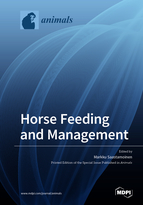Horse Feeding and Management
A special issue of Animals (ISSN 2076-2615). This special issue belongs to the section "Equids".
Deadline for manuscript submissions: closed (5 December 2019) | Viewed by 70173
Special Issue Editors
Interests: animal production; animal physiology; animal breeding; feed formulation; feeding; animal husbandry; animal genetics; forage; feed evaluation; pasture management; equine; canine
Special Issues, Collections and Topics in MDPI journals
Interests: equine production systems; equine nutrition; growth and development of the Lusitano horse; body condition and metabolic indicators; bone physiology and bone quality assessment
Interests: equine nutrition and management, especially forage production and utilization for horses, hygienic quality of feeds, equine health and welfare in relation to feeding and nutrition
Special Issue Information
Dear Colleagues,
Proper nutrition is one of the main objectives to ensure the well-being and good performance of horses. It influences the growth, reproduction, performance capacity, and health of the horse. Horse feeding is challenging for many horse owners as well as horse trainers and breeders. Many horses suffer from overweight as well as many diseases associated with nutrition. Further, other management issues, including stable and environmental conditions and feeding systems, have a major impact on the health and well-being of horses. Vice versa, horses’ management influences their environment. In addition, there are many innovations in horse feeding and management. The aim of this Special Issue is to publish original research papers or reviews concerning horse nutrition and management (including all breeds and different purposes and horse categories), and the interrelations between management, nutrition, health, wellbeing, and environment.
Areas of interest: nutrient availability and requirements of various horse categories; effects of feeding and management on performance, growth, well-being and health of the horse, as well as on the environment; feeds and feed ingredients
We invite you to share your recent findings through this Special Issue.
Dr. Markku Saastamoinen
Dr. Maria João Fradinho
Dr. Cecilia Muller
Guest Editors
Manuscript Submission Information
Manuscripts should be submitted online at www.mdpi.com by registering and logging in to this website. Once you are registered, click here to go to the submission form. Manuscripts can be submitted until the deadline. All submissions that pass pre-check are peer-reviewed. Accepted papers will be published continuously in the journal (as soon as accepted) and will be listed together on the special issue website. Research articles, review articles as well as short communications are invited. For planned papers, a title and short abstract (about 100 words) can be sent to the Editorial Office for announcement on this website.
Submitted manuscripts should not have been published previously, nor be under consideration for publication elsewhere (except conference proceedings papers). All manuscripts are thoroughly refereed through a single-blind peer-review process. A guide for authors and other relevant information for submission of manuscripts is available on the Instructions for Authors page. Animals is an international peer-reviewed open access semimonthly journal published by MDPI.
Please visit the Instructions for Authors page before submitting a manuscript. The Article Processing Charge (APC) for publication in this open access journal is 2400 CHF (Swiss Francs). Submitted papers should be well formatted and use good English. Authors may use MDPI's English editing service prior to publication or during author revisions.
Keywords
- horse
- equine
- nutrition
- feeds
- feeding
- management
- well-being
- environment
- health







